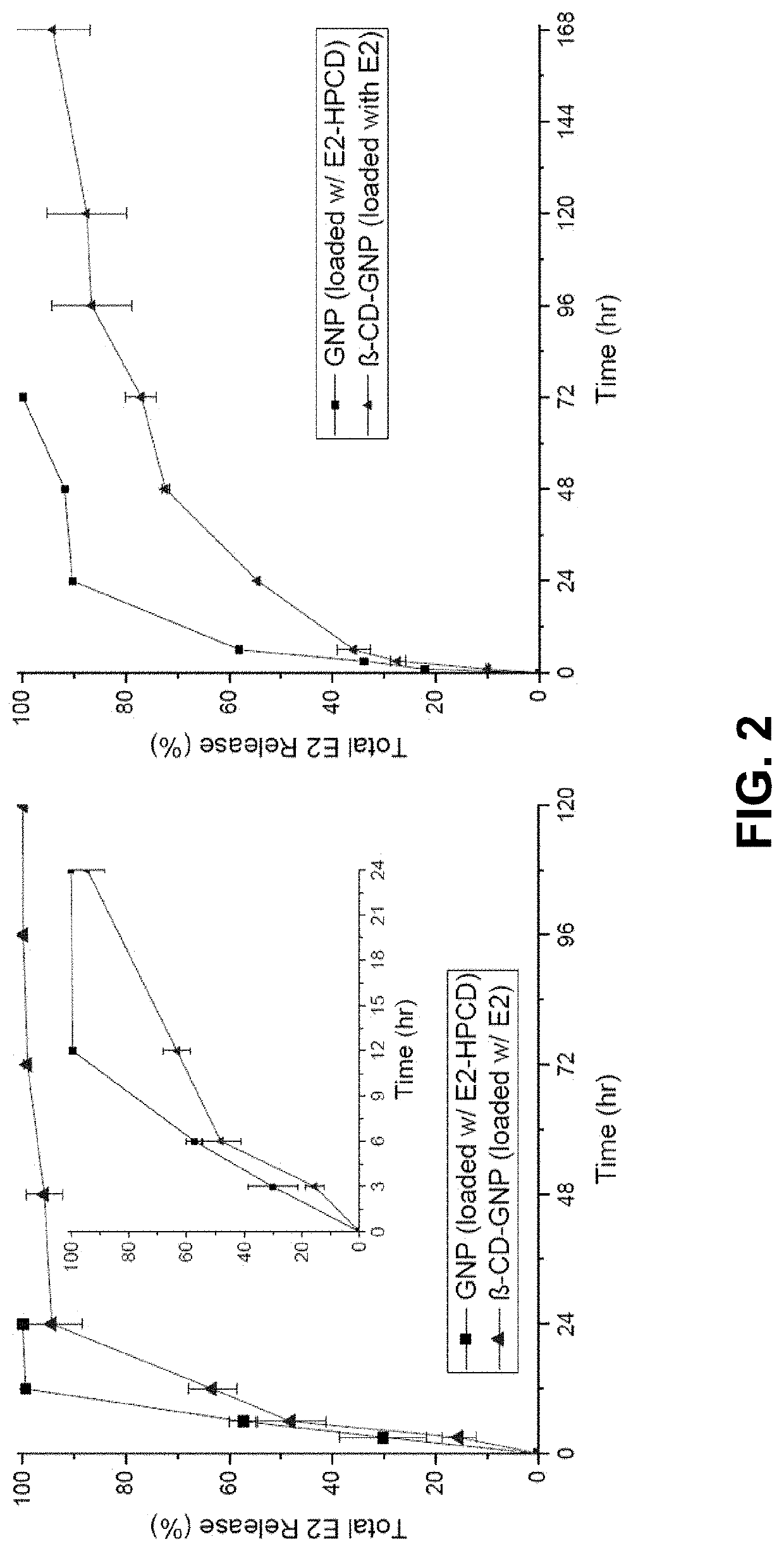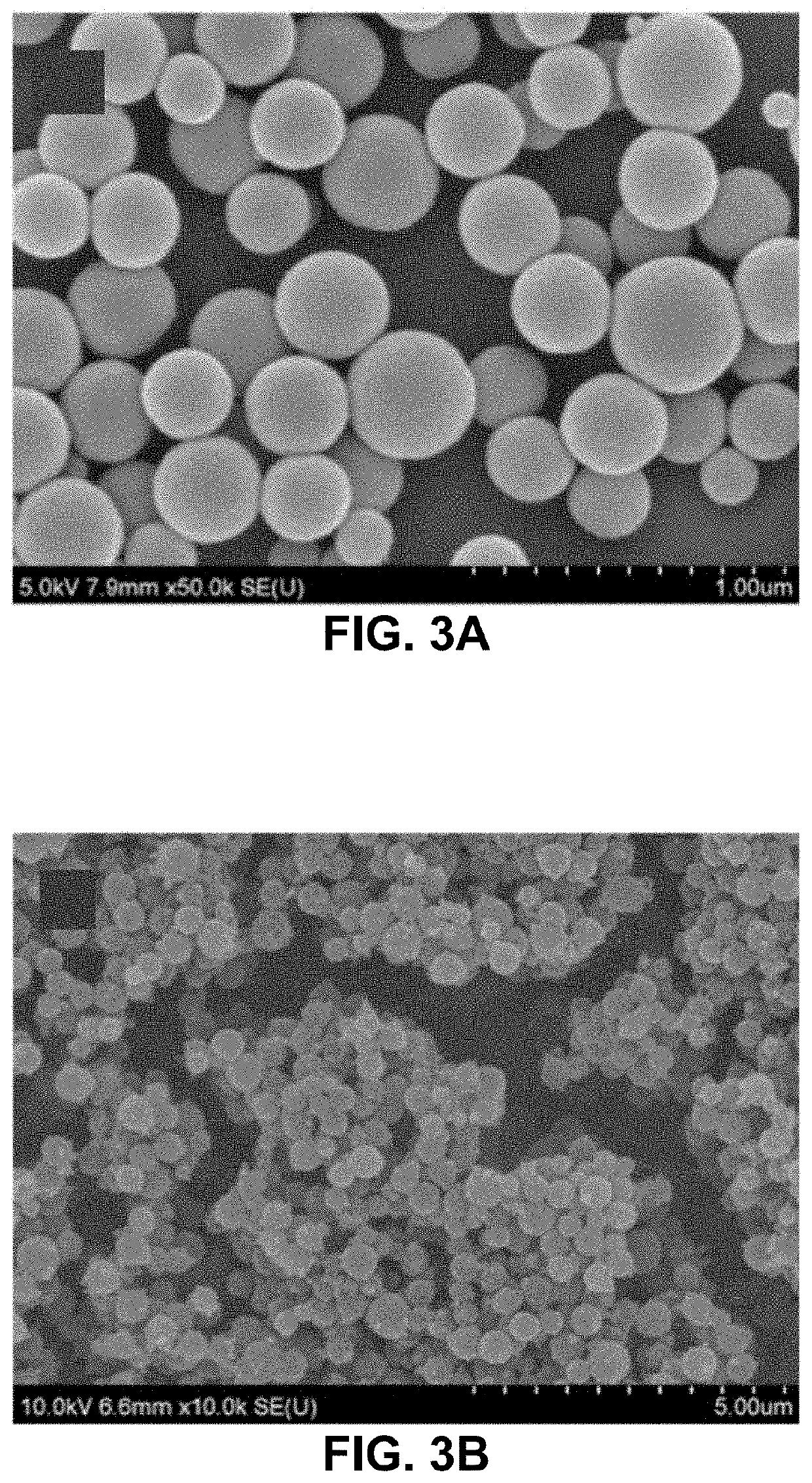Hydrogel particle carriers for delivery of therapeutic/diagnostic agents
a technology of hydrogel particles and therapeutic agents, applied in the direction of microcapsules, cardiovascular disorders, drug compositions, etc., can solve the problems of limited formulation, difficult to deliver hydrophobic, and poorly water-soluble therapeutic or diagnostic agents to water-based or aqueous environments,
- Summary
- Abstract
- Description
- Claims
- Application Information
AI Technical Summary
Benefits of technology
Problems solved by technology
Method used
Image
Examples
example 1
In Vitro Release Study
[0035]Fabrication of gelatin particles (GNPs) conjugated with β-cyclodextrin (β-CD)
[0036]500 mg of 1,1′-carbonyldiimidazole (CDI) and 100 mg of β-CD were placed in two three-necked flasks, respectively, and vacuum dried overnight. 25 mL of anhydrous dimethylformamide was added to each flask under N2. The β-CD solution was added dropwise into the CDI solution. The resulting solution was stirred for 24 h at 24° C. under N2, followed by adding 250 mL of tetrahydrofuran and 750 mL of diethyl ether. Thus-produced precipitates, i.e., imidazolated β-CD, were isolated by filtration and analyzed by 1H NMR spectrometry. 10-50 mg of imidazolated β-CD was added to 10 mL of 1-5 w / v % aqueous solution of type A gelatin (300 g bloom) at 50° C. and stirred for 24 h.
[0037]The conjugation of β-CD to gelatin was confirmed by FT-IR and 1H NMR spectrometry. 50 mL of acetone was added to the solution of β-CD-conjugated gelatin at 50° C., which was stirred until the solution became t...
example 2
In Vivo Study Intranasal Administration
[0039]Globally, ischemic stroke is a leading cause of death and adult disability. Previous efforts to repair damaged brain tissue following ischemic events have been hindered by the relative isolation of the central nervous system. A gelatin particle-mediated intranasal drug delivery system was found to be an efficient, non-invasive method for delivering 17β-estradiol (E2) specifically to the brain, enhancing neuroprotection, and limiting systemic side effects. Young adult male C57BL / 6J mice subjected to 30 min of middle cerebral artery occlusion (MCAO) were administered intranasal preparations of E2-GNPs, water soluble E2, or saline as control 1 h after reperfusion. Following intranasal administration of 500 ng E2-GNPs, brain E2 content rose by 5.24 fold (p<0.0001) after 30 min and remained elevated by 2.5 fold at 2 h (p<0.05). The 100 ng dose of E2-GNPs reduced mean infarct volume by 54.3% (p<0.05, n=4) in comparison to saline treated control...
example 3
In Vitro Release Study: Bile Acid-loaded β-CD-Conjugated Gelatin Nanoparticles
[0060]In Vitro Bile Acid release rate over time was studied for two different sizes, 170 and 400 nm diameter, of RCD-conjugated Gelatin Nanoparticles. The bile acid was encapsulated in the βCD-GNPs using the procedure described above.
[0061]Deoxycholic acid (DCA), a bile acid (BA), was used for the in vitro release experiment. In other embodiments, other bile acids, such as chenodeoxycholic acid (CDCA), can also be encapsulated in the βCD-GNPs.
[0062]For the release study, 2 mg of BA-loaded particles with diameters of 170 and 400 nm were used, showing the release rate controlled by the particle size.
[0063]FIG. 5 shows a graph of the release profiles for the two different sizes of nanoparticles.
PUM
| Property | Measurement | Unit |
|---|---|---|
| diameter | aaaaa | aaaaa |
| diameter | aaaaa | aaaaa |
| diameter | aaaaa | aaaaa |
Abstract
Description
Claims
Application Information
 Login to View More
Login to View More - R&D
- Intellectual Property
- Life Sciences
- Materials
- Tech Scout
- Unparalleled Data Quality
- Higher Quality Content
- 60% Fewer Hallucinations
Browse by: Latest US Patents, China's latest patents, Technical Efficacy Thesaurus, Application Domain, Technology Topic, Popular Technical Reports.
© 2025 PatSnap. All rights reserved.Legal|Privacy policy|Modern Slavery Act Transparency Statement|Sitemap|About US| Contact US: help@patsnap.com



